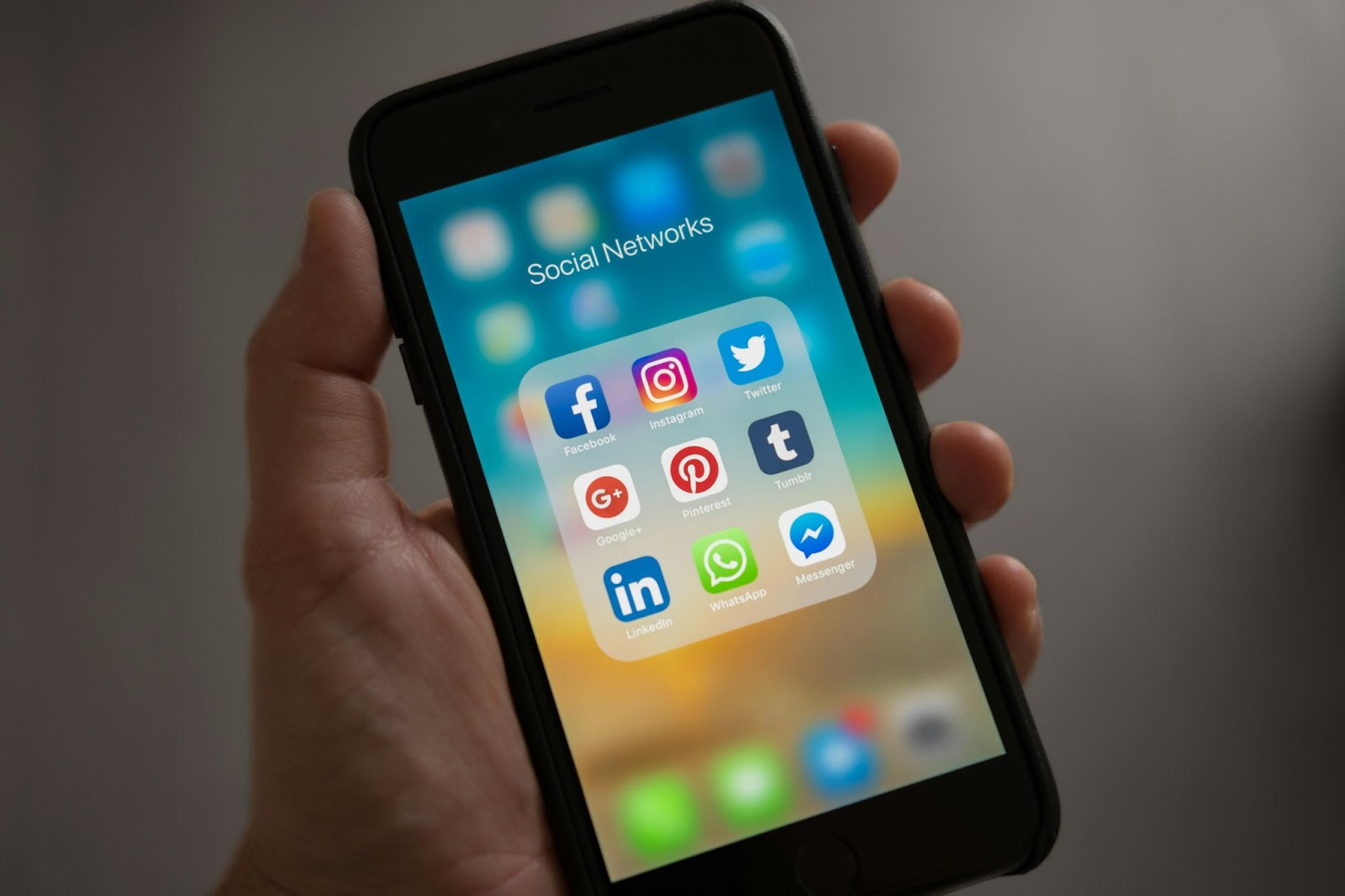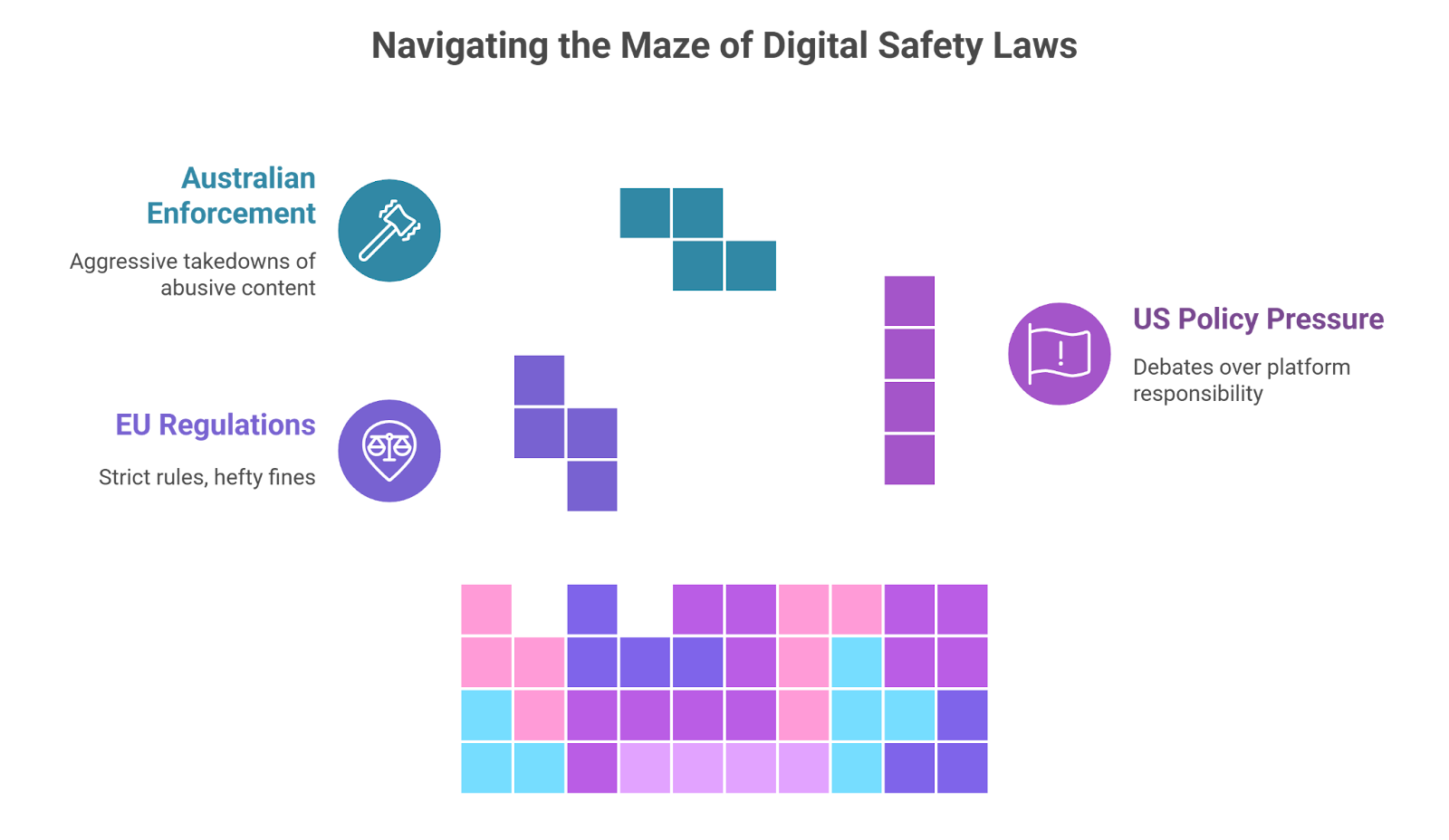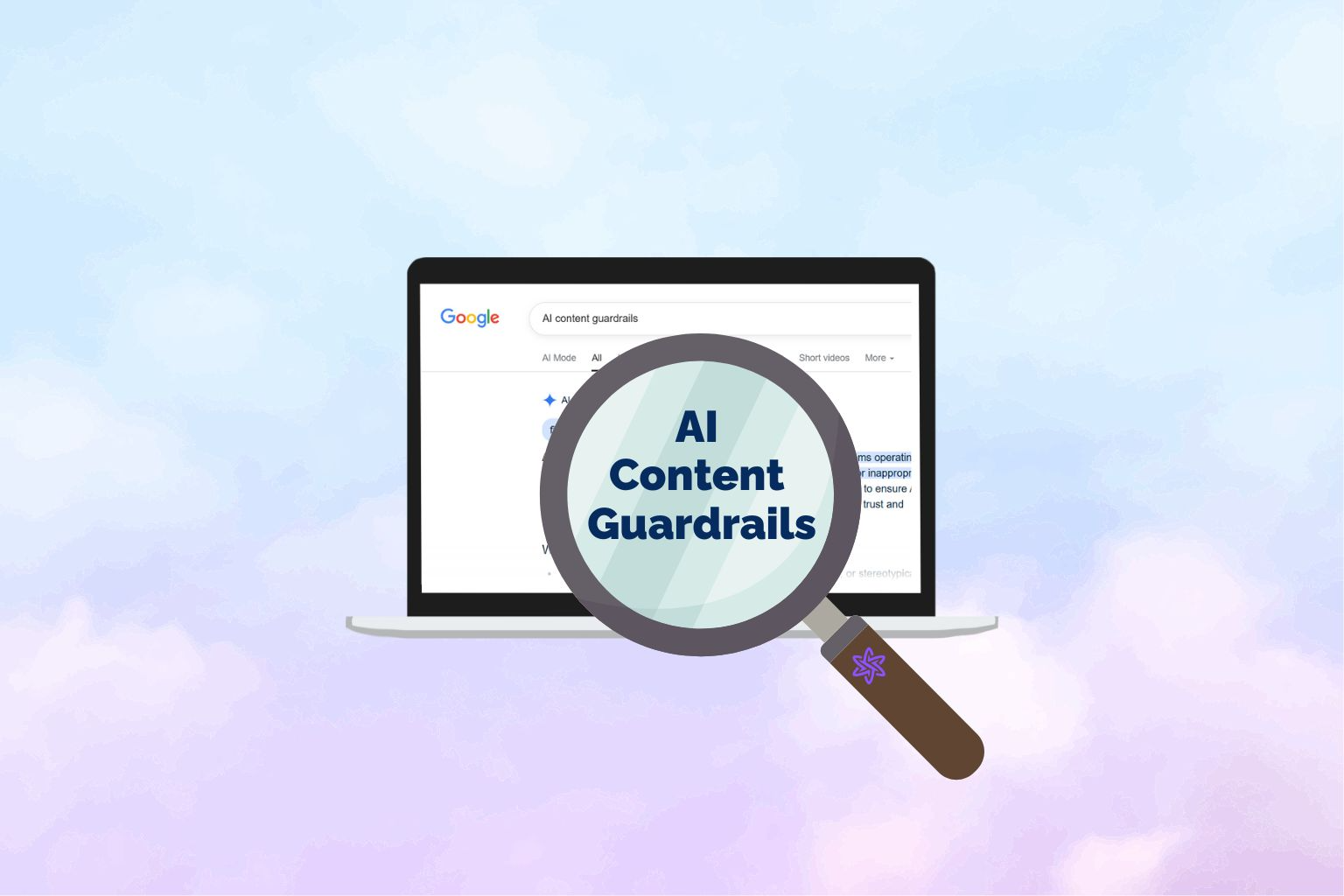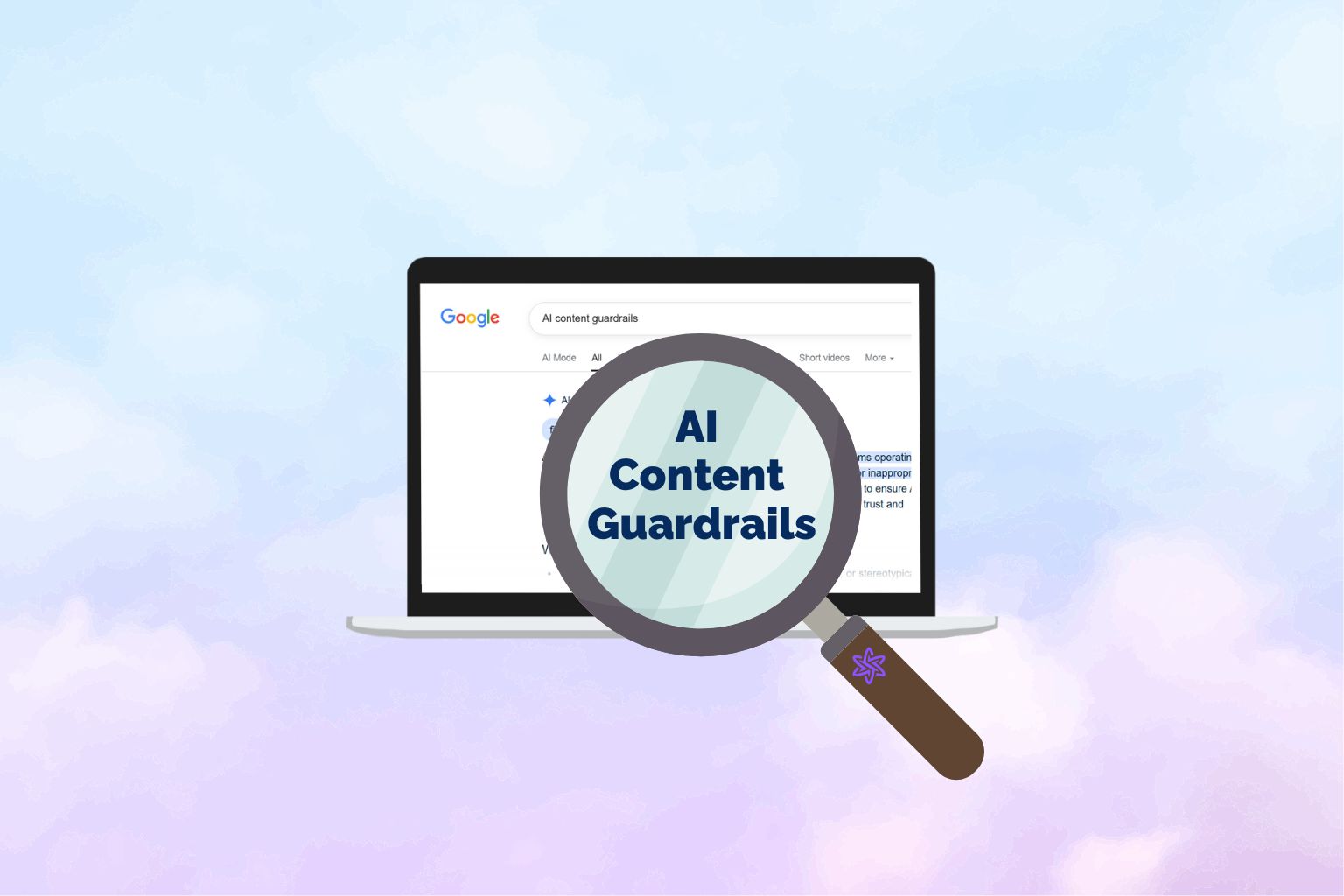Content Safety & Toxicity Guardrails: Building Safer Digital Communities

.png)
Key Takeaways
▶ AI guardrails and content safety systems are essential for protecting users from harmful, biased, or toxic content — turning the internet into a safer, more trustworthy space.
▶ Proactive, transparent, and adaptive guardrails not only ensure compliance and user trust but also prove that safety and free expression can coexist in the digital age.
1. Introduction
Throughout its history, the internet has always been a potential source of community, creativity, and connectivity. However, over the last decade, it has become a space of harassment, hate speech, misinformation, and other harmful material that erodes trust in digital platforms. Moreover, for many users, scrolling through a social feed or engaging with AI systems now feels dangerous - it is a constant threat of confrontation with harmful or manipulative content.

Artificial intelligence complicates this situation exponentially. Generative AI and recommendation algorithms have accelerated the spread of harmful content in ways that have never been possible before, and often produce harmful or biased output themselves. On the other, the same AI technologies hold the key to building smarter, more adaptive systems of protection — frameworks often referred to as Content safety guardrails, toxicity guardrails or AI guardrails.
This dual reality raises the central question: How do we ensure content safety in a world where technology is both the culprit and the cure?
We’ll explore that question step by step:
╰┈➤ Define what toxicity guardrails are and why they matter.
╰┈➤ Unpack the challenges of keeping digital spaces safe and examine real-world failures that highlight the urgency of strong protections.
╰┈➤ Turn to solutions — the role of AI guardrails, how harmful content detection works at scale, and the delicate balance between free expression and safety.
╰┈➤ Study examples of platforms and companies that have successfully implemented guardrails, showing what progress looks like in practice.
2. What Are Content Safety Guardrails? Toxicity Guardrails?
When people talk about content safety guardrails, It's all about the systems and practices that keep the harmful, unsafe or manipulative content away from users altogether. These guardrails can be technical — like AI content filters or automated moderation algorithms — or they can be policy-driven, such as platform rules, reporting mechanisms, and community guidelines.These systems – collectively – are the invisible architecture that preserves usability and trust in digital spaces.
Within this larger framework, toxicity guardrails specifically target harmful behaviors like harassment, hate speech, slurs, and manipulative content.Think of these systems as the “seatbelts and airbags” of the online world – you will not even see them during a typical interaction, but they are the systems that prevent a major crash when issues pop up!
They are not about censorship; they are about aligning conversations, platforms, and AI systems with human values, user safety and reliability of digital ecosystems. Guardrails protect healthy online spaces so users can have civil conversations without abuse.
2.1 Why Do They Matter?
In the absence of strong toxicity guardrails, digital platforms can quickly spiral into unsafe environments. Unchecked harassment clogs platforms, misinformation breeds misinformation, and AI systems are likely to generate outputs that are biased, offensive, or potentially harmful. Without adequate guardrails, content safety fails – putting individual user experiences at risk and de-stablizing the digital ecosystem as communities lose trust.
The impacts extend beyond individual users:
╰┈➤ For businesses, guardrails mean reputation crises, declining user engagement, and enhanced liability risks.
╰┈➤ For users, it means emotional harm, manipulation, and finding an alternative source of entertainment and information.
╰┈➤ For AI companies, it is even more pronounced. With the EU AI Act and the Digital Services Act enforcing rigid parameters, respecting AI guardrails has transitioned from a best practice to a legal obligation.
To sum up, guardrails are no longer a “nice-to-have.” They are the minimum framework for safe, sustainable, meaningful engagement within digital communities.
2.2 Breaking Down the Core Principles of Content Safety
Toxicity guardrails are built on a few key principles that make them effective:
╰┈➤ Prevention first: Guardrails must intercept harmful content before it reaches audiences - be it AI content filters or proactive moderation policies.
╰┈➤ Adaptivity: Online harms evolve quickly, what was safe this morning may not be later today - guardrails must evolve to keep up.
╰┈➤ Transparency: Users should know why content was flagged, restricted or removed.
╰┈➤ Balance: Guardrails must protect users and mandate freedom of expression - which is thin but critical.
╰┈➤ Scalability: Digital platforms host billions of interactions daily. Effective online safety tools must operate at this massive scale.

Together, these principles define what makes toxicity guardrails effective: not just filters, but a system that adapts, explains, and protects.
3. The Problem: Why Content Safety Feels Impossible Today
The digital realm was originally envisioned as a platform for making connections and expression with creativity. Instead, the environment is harsh and damaging. Every day millions of users come face to face with abusive language, deception, and manipulative content that jeopardize individual welfare and societal trust. Although content moderation exists as a norm, the sheer scale and sophistication of these threats makes content safety seem more daunting than ever.
3.1 From Trolls to AI: The Growing Wave of Harmful Content
Initially, the first threats to online spaces were human-based; trolls, hate groups, and spammers taking advantage of a platform, devoting their time to harass users or propagate their cause. Naturally, those behaviors became more ingrained into the fabric of society. Now while misinformation, hate speech, and harassment were previously limited to hit-and-runs - they now have transformed into systemic issues driven by a coordinated group and algorithms postpartum- boost, that are relentless in their amplification.
╰┈➤ Studies show toxic comments constitute up to 30-40% of interactions on some of the biggest platforms in unmoderated spaces.
╰┈➤ Online gaming communities, once created to facilitate fun, are often cited as the most toxic area for users, where bullying and slurs prevail.
╰┈➤ Social media platforms like Twitter/X and Facebook have faced backlash for hate speech, conspiracy theories, and violent ideation.
So what is the outcome? Toxicity is no longer a side effect, toxicity is now part of their daily online diet.
3.2 When Technology Becomes a Threat: AI-Generated Toxicity
The advancement of artificial intelligence has greatly amplified the issue. Large language models and generative AI implementation, while effective and useful, does not eliminate potential wrong outputs - like biased response, or overtly toxic or unsafe content. If not reduced, poorly fitted AI can amplify the risks.
Some examples entail:
╰┈➤ Chatbots outputting offensive replies: instances of chatbots producing racist, sexist, and abusive responses.
╰┈➤ Deepfake technology producing negative content and misinformation at scale.
╰┈➤ Algorithmic amplification of hate posts - where prompts and algorithmically recommended engines distribute their toxic hot take to others, simply because that interaction made them upset enough to read it.
Without AI guardrails, the very technology meant to improve our digital lives becomes a threat in itself.
3.3 The Hidden Costs of Unsafe Platforms
Unsafe spaces don’t just harm individuals — they damage entire ecosystems. The consequences of ignoring toxicity guardrails are profound:

╰┈➤ Consequential factors of Mental Health: Victims of online harassment have increased stress, anxiety, and withdrawal from the online space.
╰┈➤ Loss of trust: Users lose trust in platforms when content safety fails to be a priority – and users try a competitor.
╰┈➤ Business and legal risk: Companies without strong guardrails risk reputation crisis, lost revenue, and penalties under upcoming regulations like the EU AI Act and Digital Services Act.
In other words, the price of neglecting online safety tools is steep — both human and financial.
4. When Content Safety Guardrails Break: Lessons from Failure
Even with billions of dollars invested in content safety guardrails, major digital platforms still have significant institutional failures protecting their users. These failures aren’t minor miscues, they demonstrate how tenuous online ecologies can be when guardrails are inadequately defined and implemented, or even throw away for engagement. Each failure is a warning signal: without effective toxicity guardrails and robust AI guardrails, platforms lose control of their environments, trust collapses, and users are left unprotected.
4.1 Social Media’s Ongoing Struggle with Toxic Spaces
Social media platforms are the most visible arenas where content safety guardrails are constantly tested — and too often, they fail. The very characteristics that make platforms engaging, such as anonymity, virality, and personalized feeds, can also create a comfortable ecosystem for harmful behaviors.
╰┈➤ Twitter/X: After making extreme cuts to moderation staff during 2022 - 2023, watchdog organizations noted a 50 - 60% rise in users’ visibility to hate speech.Without strong AI guardrails or adequate AI content filters, toxic hashtags and harassment campaigns spread unchecked, driving away advertisers and undermining the brand’s credibility.
╰┈➤ Facebook: Internal content research (the “Facebook Paper”) documented essentially provocation for anger and outrage was algorithmically amplified. This meant harmful posts often received wider reach than safer ones — a direct failure of toxicity guardrails.

╰┈➤ Reddit: Its community-driven model shows the limits of human moderation without scalable online safety tools. Numerous subreddits that directly related to hate speech, conspiracies, and extremist content had to be banned because they could not be reined in by current practices.
╰┈➤ Instagram & TikTok: Both platforms have taken heat for being unprotected vectors for harmful content targeting kids, from bullying to pro-eating disorder communities. Despite deploying harmful content detection technologies, many unsafe posts still slipped through, showing how fragile guardrails can be under pressure.
The takeaway is clear: reactive moderation isn’t enough. Without predictive, adaptive content safety guardrails, platforms allow harm to occur first and deal with the fallout later — often after irreversible damage has been done.
4.2 AI Gone Wrong: When Machines Generate Harm
Artificial intelligence was expected to strengthen online safety tools, but when left without guardrails, AI has become a new source of unsafe content.
╰┈➤ Microsoft Tay (2016): Within a day of being launched, the chatbot was sharing racist and misogynistic content simply by mimicking toxic users’ behavior. The lack of toxicity guardrails at launch turned a promising experiment into a cautionary tale.
╰┈➤ Large Language Models (LLMs): Generative AI tools designed for user interactivity were “jailbroken,” again with relatively basic instructions that led to dangerous outcomes, including biased stereotypes or abusive behavior. Without embedded AI guardrails, these systems amplified the very problems they were meant to solve.
╰┈➤ Deepfakes: Manipulation of media by AI systems became a major risk, whether it was fake political speeches or serious harms like non-consensual sexual imagery. deepfakes represent a breakdown in trust and safety in AI when guardrails are absent.
╰┈➤ Algorithmic amplification: Recommendation systems are driven by engagement. What this means is toxic posts go the farthest, and fastest - because outrage and controversy yield attention. This shows how the lack of AI content filters and value-sensitive guardrails directly shapes user experiences.
Instead of reducing risks, unprotected AI often magnifies them. Without careful integration of AI guardrails, technology designed to filter toxicity can end up spreading it.
4.3 Regulators Step In: Laws for Digital Safety
When platforms fail to maintain effective content safety guardrails, ultimately, governments had no choice but to act. Regulations were already the baseline for what guardrails must be.
╰┈➤ European Union: The Digital Services Act (DSA) and AI Act impose strict rules on harmful content detection and transparency. Non-compliance can result in fines of up to 6% of global revenue, forcing companies to treat guardrails as a legal obligation.
╰┈➤ United States: Section 230 debates show increasing pressure that platforms be held accountable for toxic content. State-level laws, like California’s Age-Appropriate Design Code Act, show that trust and safety in AI is becoming a national policy concern.
╰┈➤ Australia: The eSafety Commissioner has earned international acclaim for taking strong enforcement actions against material that is violent or abusive. proving that governments can and will enforce toxicity guardrails when companies don’t.

These regulations send a powerful signal: AI guardrails and content safety guardrails are no longer optional features — they are compliance requirements.
4.4 What These Failures Teach Us
Examining these examples of failures offers important learnings for businesses, policymakers, and AI developers:
╰┈➤ Before things go wrong, the guardrails need to be proactive. Post-harm is no longer an acceptable standard.
╰┈➤ Scale makes AI solutions necessary. With billions of interactions a day, we can’t rely on human moderators. No one has enough of them. We need adaptive AI content filters and automated online safety tools.
╰┈➤ Clarity creates trust. Users should understand why content was flagged or removed. Obscure policies create damage to the user’s trust in the system.
╰┈➤ Trust is the best currency. Once users lose trust in the platform’s ability to manage content safety guardrails, it is almost impossible to friction them back.
So what do you get from failure? Most importantly, not only are failures stories to learn from, failures are often guides. Each failure highlights the importance of why toxicity guardrails and AI guardrails need to be incorporated from the ground up, not added on once the system is already failing.
5. The Solution — How AI Guardrails Build Safer Platforms
When platforms operate without solid content safety guardrails, the outcomes are almost predictable: bad content proliferates, communities splinter, and trust erodes. Section 4 reviewed the level of failures realized when guardrails fail or are absent. Let’s now discuss the solution—specifically, the systems and tactics that can provide safety in digital spaces.
The foundation of this all work is; AI guardrails and toxicity guardrails—protection systems that work as a digital immune system, constantly scanning, filtering, and responding to unsafe content so it is not onboarded all while ensuring openness, creativity, and healthy engagement transpire.
5.1 What are AI Guardrails in Content Moderation?
The AI guardrails refer to technical and policy mechanisms incorporated into the digital platform to prevent unsafe content from being created or amplified. Unlike moderation teams that operate based on responses to harm, these systems are designed for risks to be mitigated in real time.
In the larger sub-category of content safety guardrails these accomplish a few things:
╰┈➤ Classification algorithms trained specifically to identify incentive patterns of hate, toxic, or misinformation.
╰┈➤ Reinforcement Learning from Human Feedback (RLHF)—identifies the model’s ability to understand the distinction between valuable harm and harmless expression.
╰┈➤ Contextual Awareness Systems—use of satire or reclaimed language is contextually curated.
╰┈➤ Audits trails and transparency—explicitly shows content flagged and how the review process worked, including user appeals.
📌 Example: Google’s Perspective API won’t delete content but does identify and score levels of toxicity, and user may flag as “you probably don’t want to say that.” So, these types of smaller effects of a “toxicity guardrail” can reduce harm and harm, whilst allowing freedom of speech.

5.2 Harmful Content Detection at Scale
The biggest issue for any platform is volume. Volume is in the billions of posts, videos, and AI outputs every single day. Human moderation can not keep up. AI guardrails extend the functionality of content safety guardrails to a level of volume that no human team could possibly reach.
We have a lot of different technologies working together here:
╰┈➤ Natural language processing (NLP) classifiers, in real-time, identify toxic speech, hate, or disinformation.
╰┈➤ Our computer vision systems check images and videos for explicit or violent content.
╰┈➤ Multimodal AI language models use signals from text, images, and audio, and can catch unsafe memes, deep fakes, or mixed media.
╰┈➤ Behavioral analysis tools, help identify outlying patterns (i.e. coordinated harassment) or patterns driven by influencer bots who spread disinformation campaigns.
📊 Data point: Meta noted that in 2023, 97% of hate speech removals from Facebook were identified by AI before any users reported them online. Similarly, in 2022, TikTok removed over 100M videos, and over 90% of them were removed in a proactive way through AI content filters.
📌 Example: YouTube has an automated detection feature which removes millions of videos, that are harmful, every quarter. Before those videos are ever seen. Discords grooming AI will flag predatory behavior to protect users in their private chats - and Twitch has moderated away harassment from the live-stream platform through automated features.
Without any of these content safety guardrails - platforms would drown in harmful material - and users would just leave.
5.3 Balancing Free Expression and Online Safety Tools
Even the most complete toxicity guardrails need to tackle the most challenging topic - online safety while maintaining free expression. Too much online safety and you look like you are censoring, too little online safety and you allow toxicity to flourish. When you look for a solution - it’s ultimately balanced, with modern online safety tool providing balance.
We don’t use bans, we use a series of graduated interventions. Some features or posts may simply be blurred or down-ranked without removal. Some may even have warnings for users to decide as well.
Transparency is also part of the solution. Platforms that can explain the reason for flagging the content seems to help build trust. Appeals processes also help build this trust, by allowing users to appeal moderation.
📌 Example: Meta’s Oversight Board which processes controversial cases and provides independent legitimacy to their moderation processes, including that by AI guardrails.
📌 Example: Snapchat sends safety nudges, when sending potentially harmful messages, and lets users reflects, while encouraging self moderation without a full ban.
This balance allows content safety guardrails to protect, while allowing real conversations.
5.4 Why Strong Guardrails Build Stronger Platforms
Investing in content safety guardrails isn’t just about compliance; it’s about fostering healthier, more resilient platforms. The benefits are substantial:
╰┈➤ User trust: Research has found that over 70% of users will abandon platforms with harassment or abuse.
╰┈➤ Advertiser trust: Advertisers’ both large and small will be hesitant to advertise within unsafe content; guardrails fortify revenue.
╰┈➤ Regulatory compliance: The categories of harmful content detection require these guardrails, both the EU AI Act and the Digital Services Act carry steep penalties for non-compliance.
╰┈➤ Innovation space: By having AI guardrails, platforms can spend time developing new features as opposed to putting out fires and treating issues.
📌 Examples: YouTube investing in AI content filters after the “Adpocalypse” crises, to not only regained “advertiser/publisher trust” but reinstated long-term sustainable “business” practices.
📌 Examples: Wikipedia has preserved above-average trust due to its hybrid model, where AI flags problematic content and human moderators provide the “judgment”.
Platforms willing to implement “toxicity guardrails” not only receive “safety” but “sustainability” as well.
5.5 The Future of AI Guardrails
In the future, AI guardrails are going to take on new characteristics. Some will come suited as new features, while others will represent ideological and cultural changes.
╰┈➤ Personalized safety settings: Users will soon be able to set their own thresholds (strict, moderate, open), or more specifically have individually delineated content safety parameters.
╰┈➤ Real-time generative AI guardrails: This is a vague thought, but now imagine an image generator where the engine does not render unsafe deepfakes but still allows for parody to enter the frame.
╰┈➤ Global consistency: As regulations become identical across countries, online platforms are going to need online safety tools on their platforms to meet multiple legal standards at once.
╰┈➤ Explainable moderation: A future system could not only flag a harmful content but also show users the reasoning it relied, providing more transparency and therefore more trust.
In other words, the question isn’t whether or not “platforms” will use content safety guardrails, it will be about how adaptive, transparent, and usable they can make it.
6. When Guardrails Work: Success Stories to Learn From
If failure shows us what not to do, then success illustrations demonstrate what is possible with properly built and implemented content safety guardrails. All across the board industries, platforms take the chance to show that content safety can be balanced with openness; it has shown that when AI guardrails are placed there not only does it provide protection to users but ultimately builds trust for the long haul.
Here are some of the greatest examples by type of success which really shows the important steps their ecosystem took.
6.1 Social Media Platforms That Learned to Scale Guardrails
YouTube: Advertising crisis to safer ecosystem
In 2017 YouTube faced what is now commonly known as “Adpocalypse” when brand partners saw their ads next to extremist and harmful content. When major brands began boycotting YouTube, YouTube that had taken the chance of neglecting brand safety, went on to invest millions in AI content safety filters and harmful content detection systems. Today, over 90% of the videos taken down in violation of policies were caught by AI, before anyone had viewed the content over the next years. As proven today YouTube continues to publish transparency reports quarterly to reflect on how they have protected advertisers and users with their content safety guardrails.
TikTok: Moderation at scale with proactivity
TikTok faced scrutiny as a popular highly visual video app, widely adopted for sharing viral content and was negatively impacted by several unsafe challenges and dangerous content.

In a similar direction, TikTok developed toxicity guardrails which combined human moderators in conjunction with AI enabled scanning. In 2022, TikTok reported over 100 million videos, out of the total mass amount of videos removed content safety, 90% of that content was taken down before anyone saw it. Other online industry safety tools such as “Family Pairing" (parental control) and warning/proactive alerts for harmful content has propelled TikTok to the innovative fore-front of harmful content detection at scale.
SnapChat: Safety nudges for youth
SnapChat presents a novel methodology for embedding AI guardrails into private communication. Their “nudges” will try to identify when a user is about to send potential harmful or inappropriate content and suggest reconsidering sending it. They also leverage machine learning to detect grooming behavior, providing an extra layer of protection for its younger users. Instead of outright bans, these guardrails encourage positive actions to promote safer behavior while giving the user back your power and control, which fits their way of helping keep children safe.
6.2 Community-Driven Platforms That Balance Openness and Safety
Wikipedia – The Hybrid Model
Despite being a relatively open editable wiki, Wikipedia is among the best trusted sources of information on the internet today, and it was developed after some of the most sophisticated communities of experts. The essence of Wikipedia is their hybrid guardrails! Medieval interpretation, AI bots, like ClueBot NG, revert outright vandalism and hate speech in seconds, while gentle nudges from humans can handle anything in between. The combined application of AI guardrails + community moderation creates a remarkably strong mechanism. Wikipedia also shows that an open two-way source with clear community rules and intelligent automation maintains free speech options.
Reddit – From Chaos to Guardrail Rules
Historically, Reddit has struggled with problematic and toxic subreddits, but they have begun making substantial efforts with robust safety guardrails. Auto detection systems alert moderators to posts, along with “fast” enforcement, led to bans of hate subreddits that spread misinformation and banned a moderator for malicious withholding of DOMA action. By addressing toxic guardrails, in addition to community moderators, Reddit has rewritten some of their most chaotic places into some of the most functional, rule-based, safe community of users.
Discord – Managing Private Spaces
Discord is one of the more challenging because of their semi-private nature of their servers. However, they have laid the groundwork for safety tools with AI guardrails meant to mitigate grooming, violent extremism, and harassment. Their "Clyde AI" moderation assistant is able to detect unsafe conversations and notify server administrators in real-time. Discord's approach to privacy versus safety shows that online safety tools can work in a decentralized context.
6.3 AI Companies That Build Guardrails Into the Core
OpenAI: Guardrails at Core
As the creator of ChatGPT, OpenAI has made toxicity guardrails foundational to its system design. Guardrails filter unsafe prompts (e.g., commands to generate weapons or prohibited products) and prohibits unsafe outputs from reaching users. Through techniques such as reinforcement learning from human feedback (RLHF) and ongoing red-teaming, OpenAI built systems with core AI guardrails rather than treating it as an afterthought. Transparency reports, and peer-reviewed research studies also support trust and safety of AI.
Anthropic: The Constitutional AI Model
Anthropic, the creator of Claude, is credited with inventing Constitutional AI. Rather than having prescribed rules, it uses a constitution - a structure of values that align with the model’s output. The constitution operates as guardrails for content safety and is flexible across contexts with the ability for the model to better balance helpfulness and safety. This gives hope in future developments and guides for AI guardrails, that they can be explainable, flexible, and principled instead of restrictive or obscure.
Google: Perspective API and Other Ways
Google’s Perspective API is utilized by news sites and discussion forums for news comments and platforms to score the toxicity of comments in real-time. Instead of outright blocking, it issues warnings or metrics and relegates moderation to the users that use the tools. Google represents a model for allowing local communities to moderate content and providing them with trusted AI tools. In combination with its work on harmful content moderation on YouTube, Google will most likely be a world-leader in AI-based content filter tools at scale.
6.4 Regulation and Governance as Effective Guardrails
Meta’s Oversight Board
Meta’s Independent Oversight Board was put in place to review high-profile moderation cases as an extra-independent check on toxicity tools deployed on Facebook and Instagram. All of this is not without some drama but very much represents one of the most ambitious attempts at accountability and transparency in overseeing blatantly high-risk, broad-scope content safety tools and guards.
European Union’s Digital Services Act (DSA)
The European Union’s DSA imposes stricter requirements on detecting and reporting harmful content, implementing systemic AI guardrails. It went into effect in 2023, which has already led platforms to start to publish risk assessments and invest in better safety tools have included TikTok, YouTube, and Meta.

6.5 Lessons From Success
Across all of these examples are a few recurring themes.
╰┈➤ Proactivity — guardrails are set up to detect risks before they escalate.
╰┈➤ Transparency builds trust — users are more willing to accept moderation when they have an explanation for a decision.
╰┈➤ Balance is important — successful systems protect users, but also do not mute legitimate voices.
╰┈➤ Adaptability is essential — from viral trends on TikTok, to edits to Wikipedia, the best content safety guardrails are active in the ecosystem.
The lesson is simple, when designed mindfully, AI guardrails and toxicity guardrails do more than diminish harm, they create safer, trusted, and sustainable platforms.
7. Conclusion
The internet has always had a dual potential: it can be the most impactful place to innovate, co-create and connect — or it can be a platform for harassment, misinformation and abuse. Over the last 20 years, we have seen both potential realized. Sites that thrived without any safety guardrails were transformed into toxic environments, and sites that built in content safety guardrails grew their credibility and resilience.
AI has only amplified that duality. AI has enhanced and powered poisonous behavior — deepfakes, misinformation, aggregation of toxic content. But AI is also a way to increase our toxicity guardrails and AI guardrails to target billions of users with real-time protections. The technology that spreads harm can become the body’s immune system of digital ecosystems — if designed well.
Referring back to the failures we talked about in Section 4, the lessons are clear. Platforms that did not include proactive content safety guardrails — like Twitter/X cutting moderation staff or chatbots released to users without toxicity guardrails — were examples of how trust can erode quickly. Meanwhile, examples in Section 6 demonstrated that safety is viable and even possible. YouTube’s investments in AI content filters, Wikipedia’s hybrid approach of automation and human editors, and TikTok’s proactive strategy to detect harmful content showed us that guardrails could be adaptable, scalable, and refined while leaving the door open for free expression.
The key message is safety and openness don’t compete with each other. In fact, the most successful communities have the most intelligent guardrails in place. With content safety guardrails built into the structure of platforms, the context allows valid organizations to flourish and distorted or abusive entities are pushed out further from the public eye.
The path forward requires three commitments:
╰┈➤ For businesses and platforms — prioritize user trust by treating safety as core infrastructure, not an afterthought. Every innovation should carry built-in toxicity guardrails.
╰┈➤ For policymakers and regulators — enforce accountability fairly, ensuring global consistency in how online safety tools and trust and safety in AI are applied.
╰┈➤ For developers and researchers — continue to push the boundaries of transparency, explainability, and fairness in AI guardrails, so users not only feel protected but also understand how decisions are made.
What’s at stake is more than compliance or reputation. It’s about the future of the digital arena. Without sufficient content safety guardrails, platforms could turn into noise and abuse – a place that cannot possibly support any meaningful dialogue. But with “content safety guardrails,” we can intentionally create safer, healthier, and more inclusive ecosystems that use technology to empower, not exploit.
The internet doesn’t have to be a battlefield. With the right guardrails, it can become the global commons (which it is meant to be)– a place where ideas circulate, communities invigorate, and voices emerge without trepidation. A future could look like this. But only if we intentionally create it.


.svg)




.png)
.svg)

.png)



